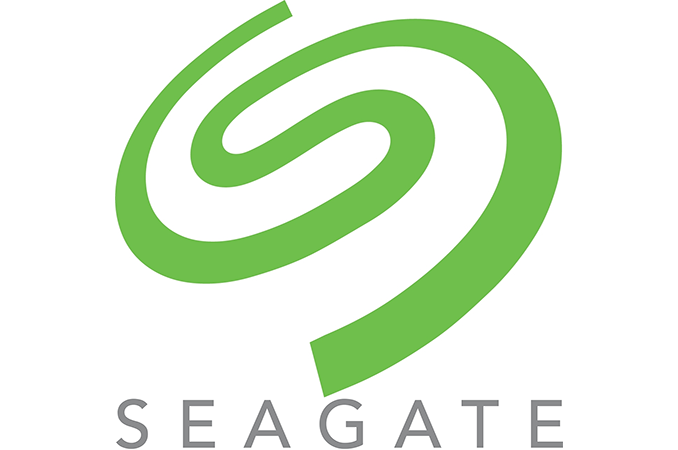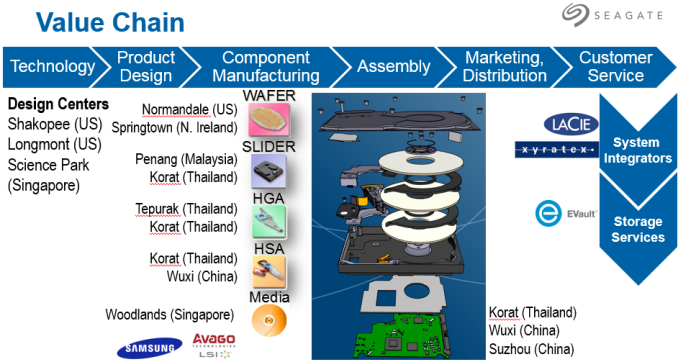Seagate to Shut Down One of Its Largest HDD Assembly Plants
by Anton Shilov on January 13, 2017 1:00 PM EST
As a part of its cost-cutting efforts, Seagate has decided to shut down its HDD manufacturing plant in Suzhou, China. The factory is one of the company’s largest production assets and its closure will significantly reduce the company’s HDD output. Seagate intends to lay off ~2200 employees, but it is unclear what it intends to do with the facility, which it owns.
The factory in Suzhou, China, assemblies hard drives and performs their final testing before shipping. The plant does not produce HDD subassemblies and thus is not vertically integrated, but at 1.1 million square feet (102 thousand square meters), this is one of Seagate’s largest manufacturing assets and the largest drive assembly facility. The company got the factory from Maxtor, when it acquired it in 2006. According to a media report, the plant no longer makes products and the last employees will be laid off on January 18, 2017.
“As part of our continual optimization of operational efficiencies, Seagate has made the difficult decision to shut down its factory in Suzhou, China,” an alleged statement by Seagate reads. “We regret that our Suzhou employees will be affected by this action, which reflects our ongoing commitment to reduce Seagate’s global manufacturing footprint and better align the business with current and expected demand trends.”
Last year Seagate announced intentions to optimize its manufacturing capacities from around 55-60 million drives per quarter to approximately 35-40 million drives per quarter. In 2016, the company already fired about 8,000 employees from different locations, but that was only a part of the strategy. With the plan to shut down the plant in Suzhou, the company actually reduces its ability to produce the drives.
After Seagate shuts down its plant in Suzhou, China, it will have two vertically integrated HDD production facilities in Wuxi, China, and Korat, Thailand. Both factories product drive subassemblies and actual HDDs, hence, by using only these two plants the company optimizes logistics (as it no longer has to transport drive subassemblies to Suzhou) and cuts its per drive manufacturing costs. Meanwhile, it remains to be seen what happens to Seagate’s factories that only produce drive subassemblies (sliders and HGAs).
| Seagate's Manufacturing, Development, Marketing and Administrative Facilities | ||||||
| Location | Primary Use | Approximate Area | Ownership | |||
| USA | California | Product Development Marketing Administrative |
842,000 ft² | Owned/Leased | ||
| Colorado | Product Development | 664,000 ft² | ||||
| Minnesota | Product Development Production of Recording Heads |
1,144,000 ft² | ||||
| Northern Ireland | Springtown | Production of Recording Heads | 479,000 ft² | Owned | ||
| China | Suzhou | Production of Drives | 1,103,000 ft² | |||
| Wuxi | Production of Drives and Drive Subassemblies (Head Stack Assembly) | 704,000 ft² | Leased | |||
| Malaysia | Johor | Production of Substrates | 631,000 ft² | Owned | ||
| Penang | Production of Drive Subassemblies (Sliders) |
402,000 ft² | ||||
| Seremban | Production of Test Equipment and Systems | 299,000 ft² | Owned/Leased | |||
| Singapore | Woodlands | Production of Media | 1,504,000 ft² | |||
| Science Park | Product Development | 410,000 ft² | ||||
| Ang Mo Kio | Marketing Administrative |
225,000 ft² | Leased | |||
| Thailand | Korat | Production of Drives and Drive Subassemblies (Sliders, Heads Gimbal Assembly, Head Stack Assembly) |
1,767,000 ft² | Owned/Leased | ||
| Teparuk | Production of Drive Subassemblies (Heads Gimbal Assembly) |
362,000 ft² | ||||
| Korea | Suwon | Product Development | 220,000 ft² | Owned | ||
It is important to note that while Seagate cuts down HDD assembly capacities, it does nothing to plants that produce heads, media and substrates. Over the past few years, unit shipments of HDDs have declined, but their average capacities increased (especially capacities of HDDs for datacenters) due to strong demand for high-capacity SKUs. Therefore Seagate may not need to produce a lot of drives, but it needs to pack about the same amount of heads and platters into fewer HDDs. Moreover, in the coming years, the company will need more heads because of new manufacturing technologies (TDMR, HAMR, etc.) and more media because it can now pack more platters into high-end helium-filled drives.
What remains to be seen is what Seagate plans to do with its manufacturing assets from the Suzhou facility. The fab is so large that it does not seem that all of its equipment could be relocated to other facilities. Moreover, the building itself is huge and it is unclear what will happen to it.
Related Reading:
- Seagate to Lay Off Over 8,000 to Lower Costs
- Seagate Revives Maxtor Brand for External Storage
- The Evolution of HDDs in the Near Future: Speaking with Seagate CTO, Mark Re
Sources: Seagate, BestChinaNews, Reuters, The Register.











44 Comments
View All Comments
Michael Bay - Saturday, January 14, 2017 - link
OYYYY VEEEEEYYYReflex - Friday, January 13, 2017 - link
If there is less to produce there is also less likely going into R&D, design, management, etc. Layoffs like this affect a company globally, not just at the factory. At the very least the logistics chain for that factory, likely managed from the US, is likely to lose their jobs.We should never root for layoffs like this, nor should we underestimate the impact on the US of such jobs just because they are not located here.
DanNeely - Friday, January 13, 2017 - link
At least initially the R&D/etc budgets shouldn't be hit much. The implosion of sales is still largely limited to the low end segment of the market which have very tiny margins. It's the 10/15k SAS drives and the high capacity 5400/7200 RPM 3.5" models that sell at margins high enough to generate the profit that funds R&D/etc.zodiacfml - Saturday, January 14, 2017 - link
Who would like layoffs? It is Seagate's refusal to accept a huge change in the storage market. They either were complacent or playing it too safe.Their enterprise drives will soon get a hit soon as they will be more power hungry and less dense than SSD's in the years to come.
They will live on, drastically smaller though, as HDDs will continue as good drives to save a ton of data that needs to be accessed in a few seconds.
Nagorak - Sunday, January 15, 2017 - link
I think the hard drive manufacturers ended up in a tough position and there was only so much they could have done about it. With SSDs the underlying technology was significantly different from HDDs. They basically found themselves in competition with the memory manufacturers, and a lot of these were pretty sizable companies which could go toe to toe with them. Seagate and WD probably should have tried to get on the SSD bandwagon sooner, but it's not clear the memory manufacturers had any intention of letting them in.Jaybus - Saturday, January 21, 2017 - link
CRT manufacturing facilities went through the same slow death. Making LCD panels is just totally different than making cathode-ray tubes. The difference was cost. LCD panels hit 50% market share in 2006, and by 2012 the last CRT manufacturer in Europe had closed. This wasn't as much because LCDs could outperform CRTs as it was because LCDs were much lower cost. HDD is having a slower death because HDD is still cheaper than SSD. When that changes, HDD will be as dead as CRT, diminished to an insignificant niche market.Lolimaster - Saturday, January 14, 2017 - link
Things is: Where the hell are the HARM HDD's?They should've been on shelves 1 year ago. 15-20TB right now, with 30TB next year.
DanNeely - Saturday, January 14, 2017 - link
They turned out to be a lot harder to make than people thought when ever the out in 2016 estimate came from.DanNeely - Friday, January 13, 2017 - link
I suspect most of the equipment in the facility will end up being scrapped. Total drive production capacity's being cut by ~35%; the building being closed is ~30% of the space in buildings where they are doing drive production.And if growth in platter counts doesn't counterbalance shrinking total numbers, we'll probably see a few more buildings closed since it's only ~10% of their manufacturing floor space.
bigboxes - Friday, January 13, 2017 - link
I don't read much into this. It's a large company that is cutting costs and becoming more efficient. No big deal.